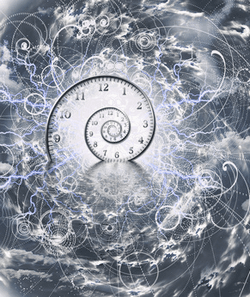Most religions have their own sense of history and perhaps predictions of human destiny. Hinduism also has it’s history, but Hinduism also has something else: It’s own unique sense of time and cosmology. It is not just about human destiny, but the destiny of the universe. Where Westerners tend to think of time as a straight line going forward forever, Hinduism seems to see time as almost circular.
Before the 1930s, before the Big Bang theory of the universe, the leading theory about the universe was the Steady State Theory. This theory held that the universe pretty much was constant, and, it would somehow go on forever. With the Big Bang Theory, suddenly we have a beginning to the universe … and an age to the universe (around 14 billion years) … which may imply there is some sort of cosmic cycle at work. There is the Big Crunch Theory which holds that the physical laws of the universe will, eventually, take the universe into old age.  According to the second law of thermodynamics, entropy will eventually turn the universe incredibly cold, and then collapse in on itself.
According to the second law of thermodynamics, entropy will eventually turn the universe incredibly cold, and then collapse in on itself.
Most people are familiar with the concept of reincarnation in Hinduism. Reincarnation is the constant cycle of life and death, of transmigrating from one life to another. Reincarnation is really about things beginning, and ending, then beginning again. In between these beginnings and endings is learning. The idea of reincarnation is woven into a the Hindu conception of cyclical time. For reincarnation to take place, vast amounts of time are required.
Now, let’s take a look at how ancient Hindu scripture looks are life, the universe and cosmology. Hinduism has traditionally divided time into units as small as microseconds to units as large as several trillion years. It is a very complex and detailed system, and too much to cover all at once. We are just going to look at a small part of how Hinduism deals with the concept of time. Something easy. But, our examination will help you begin to understand how ‘time’ fits into Hindu cosmology. We will start with the four yuccas.
The four yuccas are blocks of time. Each yucca gets consecutively shorter to the first. As one moves from the first, longest yoga, to the next, there is a sharp decline in morality. Each yucca is depicted as a bull or a cow which stands on 1, 2, 3, or all four of its legs. Let us take a look at each yucca, the block of time it represents and humanity’s place within that period of time:
1) The Satyr/Krita Yuga – The Satyr Yuga, also known as the Krita Yuga, is represented by a cow standing firmly on all four legs. Morality and righteousness are at their highest in this yoga. Everything is pure and every being acts exactly as they should. The human lifespan in this yoga is 400 years, and the yoga itself lasts for 1,780,000 years.
2) The Treta Yuga – In the Treta Yuga, the cow stands on three legs. This still makes it quite stable, but less sturdy than it was before. The state of the Tetra Yuga is still one of goodness and morality, but in a declining state. The human lifespan is cut down to 300 years, and the yoga lasts 1,296,000 years.
3) The Dvapara Yuga – The Dvapara Yuga sees the cow standing precariously on only two legs. Some strong pillars of dharma and morality remain, but there are now many things wrong with the world. The human lifespan is half of what it started at, at 200 years. This yoga lasts 864,000 years.
4) The Kali Yuga – The Kali Yuga, symbolized by the cow with only one leg, is unfortunately the age we are said to be living in right now. It is the age of vice and strife, with all virtues degenerating. The human lifespan has dropped to 100 years. This yoga is the shortest of the four, lasting 432,000 years.
These four yuccas together make a mahayuga. A mahayuga lasts for 4,320,000 years. There are 71 of these mahayugas in a mahavantara. Mahavantara’s are important units of time because they represent an age that is ruled over by one Manu, the father of humanity. We are currently said to be living in the 7th mahavantara of this cycle of creation.
A kalpa is another very important and very large unit of time in Hinduism. One kalpa is 1000 mahayugas (or 14 mahavantaras). One kalpa represents the first 12 hours of the day for the creator god Brahma, it takes a second kalpa to represents the next 12 hours, or the night. Brahma, the Creator and Creation, has a life span of 100 "years". Since two kalpas represent only one day and one night for him, this brings Brahma’s life span in human years to an astounding total of 311 trillion years.
Brahma is considered the all in everything, the universe itself, and more. However, Brahma, just like every other being, is also subject to reincarnation. So, even he must come to an end in this grand cosmic dance. Why? So he can begin anew, again. Brahma is always reborn from the naval of the god Shiva, the destroyer, often depicted as explosion and fire … and Brahma’s destiny is to create the universe, a new universe, once again.

Let Clairvoyant, Vedic Astrologer Kumari Answer Your Questions About Past, Present and Future: Call 1-800-806-5899
Would you like an impressive psychic reading? Give Psychic Astrologer Kumari a call at 1-800-806-5899, toll free Canada and US. Kumari is a talented clairvoyant who is also an expert in Vedic Astrology.
Resources You May Appreciate:
